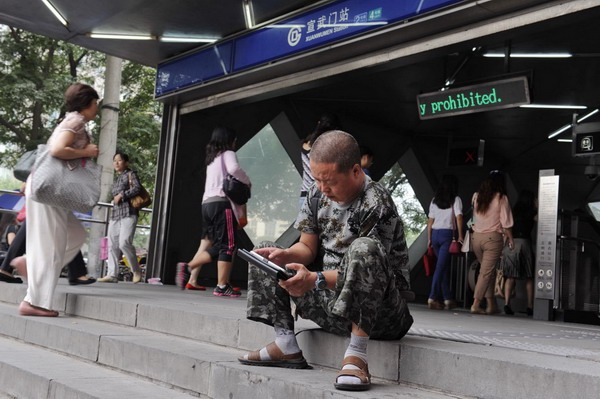Beijing subway failure raises concerns
Updated: 2013-09-16 19:17
(Xinhua)
|
||||||||
BEIJING - A technical glitch that disrupted passengers on the subway in Beijing for nearly two hours Monday morning has raised questions about safety and operator's abilities to tackle emergencies.
Subway Line 4, a major underground service that runs 50 kilometers through western Beijing from north to south, suspended its operation after a signal failure at 7:22 am.
 |
|
A man fiddles with his tablet computer outside a subway station entrance in Beijing, September 15. [Mao Shuo/Asianewsphoto] |
As one of the busiest subway lines in the nation's capital, the line carries more than one million people each day since it went into operation in 2009. The disruption forced commuters to use buses and taxis, leading to severe traffic congestion on major roads.
In the wake of the disruption, Beijing Public Transport Holdings, Ltd., an operator of ground transportation in the capital, dispatched 130 buses to carry passengers who were on the Line 4 service. Yet the fleet was far from enough to handle all the passengers.
Beijing MTR Corporation Limited, the line's operator, said train services resumed around 9:10 am.
"I had to transfer on three subway lines to go downtown," said Yan Yu, a student at Tsinghua University. "The failure delayed me for over 40 minutes."
Signal failure can cause major problems for subway passengers. The signal monitoring system is widely used in the rail network to monitor intervals between trains to ensure they travel at a safe distance.
Beijing MTR said it has technicians travelling on trains and monitoring equipment to ensure proper function.
While Monday's signal problem held up passengers for two hours, a similar problem that happened two years ago in Shanghai led to a collision of two subway trains.
In addition to delays, the signal failure on Beijing's Subway Line 4 also impacted other lines in the city. Passageways connecting Line 4 to other lines were closed. Also, train intervals on other lines were extended and carriages stayed less time at each stop as operators tried to limit the number of passengers boarding already packed coaches.
Beijing currently runs 14 subway lines carrying more than 8.5 million passengers on an average day, according to the Beijing Subway Company, which operates 12 of the 14 lines.
The subway failure comes at a time when Beijing is mulling new measures to combat traffic congestion and air pollution. The subway has become the main option for citizens as authorities limit the number of vehicles on roads and the prospect of charging for traffic congestion and pollution looms large.
Across China, cities are building subway networks as a solution to worsening traffic gridlock. Yet the growing reliance on underground transportation could make a city's traffic system vulnerable in case of a similar service disruption.
In the latest infrastructure-building boom, 28 cities have proposed adding a total of 2,710 miles of subway services in the next six to eight years, costing 910 billion yuan ($148 billion).
While urban authorities embark on a subway-building spree, they are yet to design an effective response mechanism with subway operators to deal with potential problems.
In Hangzhou, capital city of east China's Zhejiang province, a subway train stopped in between two stations last Monday. Passengers were evacuated from the train and walked half an hour to the next station. The operator failed to accommodate passengers with other means of transportation after they left the subway station.
Most Viewed
Editor's Picks

|

|

|

|

|

|
Today's Top News
Chinese FM to make US, UN trip
USDA's OK of chicken processing challenged
US top carpet maker sets up in China
States laud lifting of ban on hardwood by China
UN chief gets report on Syria chemical weapons
Succession proves a tricky art in business
Going global? Not so easy
Japan switches off nuclear reactor
US Weekly

|

|














